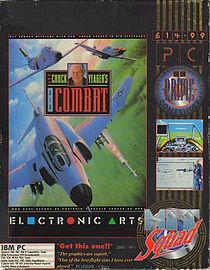- Chuck Yeager's Air Combat
-
Chuck Yeager's Air Combat 
Developer(s) Brent Iverson Publisher(s) Electronic Arts Platform(s) MS-DOS, Apple Macintosh Release date(s) 1991 Genre(s) Flight simulator Mode(s) Single Player Chuck Yeager's Air Combat is a 1991 computer aircraft simulation game produced by Electronic Arts. Famed pilot Chuck Yeager was a technical consultant in the game and his digitized voice is featured in the game, giving encouragement and praise before and after missions.
The game is characterized for its good balance of an action laden gameplay which focuses on classical dog fights and a simple but still realistic flight model which justifies calling Chuck Yeager's Air Combat a simulation. Unlike in many other flight simulation games of its day, altitude and aircraft characteristics have a big influence on the behaviour of the game's simulated aircraft. Realism has been sacrificed to some degree to enhance gameplay however: E.g. a real fighter plane expends all of its ammunition after a few short bursts, while in Chuck Yeager's Air Combat the rate of fire has been reduced considerably, making dog fights longer.
To assist a newcomer to the game several help features can be activated, such as unlimited ammunition or easier aiming. A virtual Chuck Yeager can be activated, who gives advice.
In the introduction sequence a copy-protection measure consists of one trivia question about a featured plane. The answers are in the appendix pages of the game manual.
Available for the DOS and Apple Macintosh, the latter version is considered superior as its graphical display is at a much higher resolution, multi-player network play is supported and saved movies may be exported in QuickTime format. In addition, after the copy-protection question has been answered correctly one time the game may then be started without answering any questions for as long as it resides in the same folder.
Contents
Aircraft
The game featured six player-flyable aircraft: P-51D Mustang, F-86E Sabre, F-4E Phantom II, Fw.190A-8, the Soviet MiG-15 'Fagot' and MiG-21MF 'Fishbed'. Other featured AI-driven aircraft were: Me.109E, Me.110B, Me-163B Komet, Me-262 Schwalbe , P-47D Thunderbolt, Yak-9, MiG-17MF 'Fresco' and F-105D Thunderchief as opposing fighters and B-17E, B-29C, B-52 and L-5 as aircraft to either protect or shoot down, depending on the mission.
Flying Modes
Three different fly modes were available: Free Flight, which put the user in a selected airplane in a non-hostile environment; Create a Mission, where the user could specify which airplane to pilot against a selected number of AI-driven aircraft of varying levels of difficulty; and Historical Flight, where user could select among three wars to fly in: World War II, Korean, and Vietnam.
Historical Missions
All missions are based upon actual missions ranging from strafing attacks of WWII, the open dogfights of modern air warfare, and the combat missions of Vietnam, which included bomber escorts. However, large, famous battles in the wars are not included (for example, there are no D-Day, Pearl Harbor, or Battle of Britain missions).
Campaigns
The Campaign mode of Chuck Yeager's Air Combat could be started by including the CAMPAIGN argument with the DOS command to start the game. In this mode, the player must successfully complete the missions in each war in order. Upon successful completion, a mission is marked with a small red box and the next mission then becomes available for selection and play. (In some versions, the first "page" of missions for a war is available for flying, allowing for the first three missions to be flown out of order.)
Campaign mode is quite a bit more difficult than completing Historical Missions individually. In order to successfully complete the missions, a player must land at his home base, which means that it may be necessary to destroy considerably more enemy aircraft than normal in order to ensure a safe return. Additionally, death resulting from being Killed in Action means that no more missions may be attempted on that file (the player must start a new file). Ejecting before being killed in action allows the player the possibility of attempting the mission again; however, if the ejection occurs over enemy territory there is a possibility of being captured, which then also prevents any other missions from being completed.
External links
Categories:- 1991 video games
- DOS games
- Mac OS games
- Electronic Arts games
- Combat flight simulators
Wikimedia Foundation. 2010.
